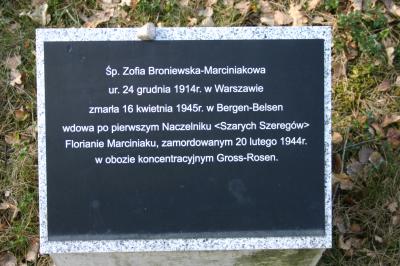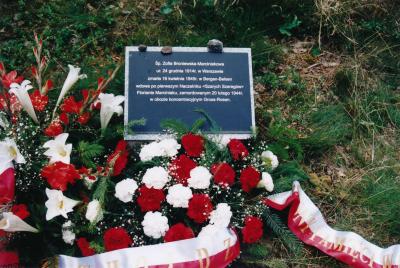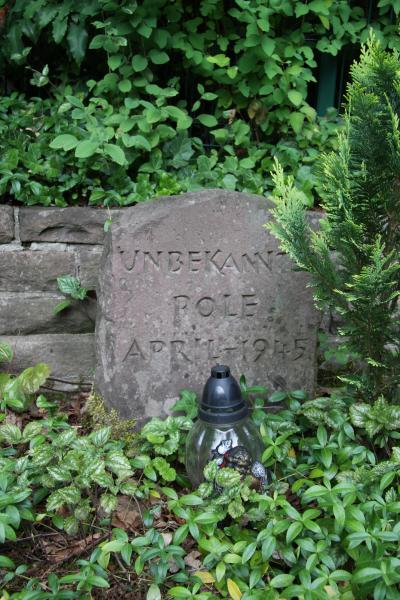Stalag XI C Bergen-Belsen
The prisoners of war were placed in three barracks, and an additional barrack for the sick was provided for them, where internee doctors took care of the prisoners' health, as far as their medical means allowed. There was a shortage of food, underwear, warm clothes and medicines. The soldiers were taken prisoner practically straight from the barricades, in light uniforms or civilian clothes, which were in a poor condition after more than two months of fighting. The Red Cross parcels improved the situation slightly and coffee, chocolate and cigarettes were exchanged for basic foodstuffs. Contrary to the provisions of the deed of capitulation, all the documents issued by the command of the uprising were taken away from the prisoners and the two million zlotys, which were in their possession, were seized. Officers were not allowed to have short weapons, even without ammunition. A small group of senior officers from the uprising command had justified fears, as the documents issued were also used to hide real military ranks and functions. Among the prisoners were "Cichociemni" (the "Silent Unseen"), soldiers of sabotage units and the command of the Grey Ranks, including Colonel Stanisław Broniewski. Contrary to the provisions of the Geneva Convention, the officers were placed in a stalag, not in an oflag.
The barracks were not adapted for the coming autumn and winter. The commanding officers proposed to organise groups of prisoners who would go under guard to the nearby forest every day to collect firewood. International conventions forbade the use of prisoners of war to work for the enemy, but in view of the prospect of living in unheated barracks, the prisoners decided to undertake this work. According to the unwritten officer code, one should use every opportunity to escape to continue the fight. This opportunity occurred when going outside the camp fence. For two prisoners, the escape attempt ended in death:
MICHAŁ BUSŁOWICZ Lieutenant a.k.a. "Bociek", "Janusz"
* 27.5.1912 Krzemienica
† 12.1944 captured in the Netherlands, shot while trying to escape again during a return transport to Bergen-Belsen
BOLESŁAW NASIOROWSKI Lieutenant a.k.a. "Edmund"
after the escape, considered missing, possibly shot during his escape in November 1944.
A few days after the arrival of the Home Army officers from the main camp in Fallingbostel, the first group of 90 women, 2 children and 8 girls serving as orderlies were also transported here. On the 1st of November, more women arrived, because of which the female part of the Stalag XI B branch was created. They were also deprived of the status of a prisoner of war and forced to work. As a result of resistance, 10 women were taken to a special SS Straflager XXI penal camp in Salzgitter-Hallendorf. In mid-December 1944, female non-commissioned officers and soldiers were taken to Stalag VI C Oberlangen. The last to leave for Oflag IX C Molsdorf were women officers. On the 10th of January 1945, they were all transferred to the main camp and the next day transported by rail to Oflag II D Groß Born. After a week's stay, they were sent on an 800-kilometre march westwards. On the 30th of March 1945, they reached Stalag X B Sandbostel. Some of the former prisoners of war went on a further 160-kilometre march to Oflag X C Lübeck.
Already in the initial phase of the Warsaw Uprising, the first transports of Warsaw civilians arrived at Bergen-Belsen. Hundreds of Warsaw inhabitants originally placed in other concentration camps were later sent to the camp with evacuation transports. Not all the Home Army soldiers decided to be confined in prisoner-of-war camps - some of the uprising participants remained in the destroyed capital. Not everyone managed to get out of the city, which was methodically pacified and destroyed by the SS and Wehrmacht troops. Many shared the fate of the civilian population of Warsaw and found themselves in concentration camps. The majority of the 2,272 Polish victims of KZ Bergen-Belsen confirmed so far were civilians from Warsaw. At least eight of them were active members of the resistance in the ranks of the Home Army and participants of the Warsaw Uprising. The names of the camp victims listed below come from various sources:
ELŻBIETA GŁAZOWSKA Sergeant a.k.a. "Głazowa"
* 29.10.1909 Warsaw
† 3.1.1945 her tomb is the only one
DOBRANOC JERZY Rifleman a.k.a. "Rejak", "K-8"
* 12.2.1927 Warsaw
† 6.1.1945
MAJER ALEKSANDRA a.k.a. "Olga"
* 1904 Kraków
† 3.1945
BIAŁKOWSKA IRENA ZOFIA (niece of Aleksandra Majer)
* 24.9.1924 Vilnius
† 4.1945
BRONIEWSKA-MARCINIAK ZOFIA
* 24.12.1914 Brześć Kujawski
† 14.4.1945
ZOFIA BRONIEWSKA-MARCINIAKOWA
* 14.12.1914 Warsaw
† 16.4.1945
WUDARSKA MARIA Nurse a.k.a. "Bakcyl"
* 22.7.1909 Ostrołęka
† 4.1945
FORNALSKI RYSZARD Rifleman a.k.a. "Tyr"
† 4.1945
CAMPIONI OLGA a.k.a. "Rita"
* 1897 Warsaw
PRZEWOŹNY PIOTR Cpl.
* 3.4.1909 Pułtusk
BARAŃSKI ZYGMUNT Rifleman
* 14.5.1928 Warsaw
DUDEK STEFANIA
GUTOWSKA ZOFIA
† 13.3.1945
HLEBOWICH WIKTORIA JAROSŁAWA
31.12.1914 Piotrogród
† 16.3.1945
KORDECKA MARIA
* 22.12.1912 Mikołajowice
† early 1945
KRAKÓWKA HELENA
* 11.8.1915 Wodzisław Śląski
† 15.4.1945
SKUPIEŃ KRYSTYNA
* 26.2.1892
† 1945
WACŁAWA LUTOBORSKA
* 28.9.1901
JADWIGA LUTOBORSKA
* 8.8.1903 Warsaw
† 4.1945
Tosia Grünberg
* Tarnów
† a few days after the camp was liberated
Paweł Przeworski
Warsaw
† 15 years, April 1945


